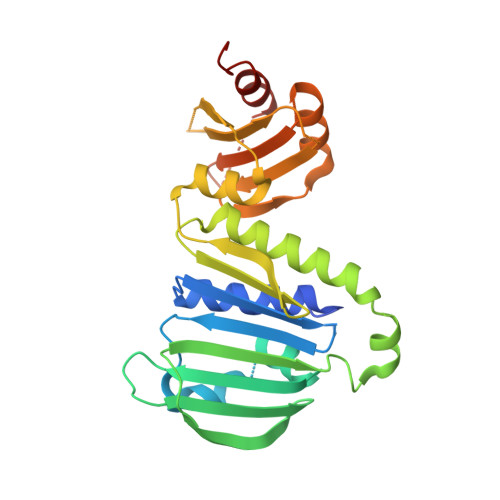A Lynch syndrome-associated mutation at a Bergerat ATP-binding fold destabilizes the structure of the DNA mismatch repair endonuclease MutL.
Izuhara, K., Fukui, K., Murakawa, T., Baba, S., Kumasaka, T., Uchiyama, K., Yano, T.(2020) J Biological Chem 295: 11643-11655
- PubMed: 32571878
- DOI: https://doi.org/10.1074/jbc.RA120.013576
- Primary Citation of Related Structures:
6LZI, 6LZJ, 6LZK - PubMed Abstract:
In humans, mutations in genes encoding homologs of the DNA mismatch repair endonuclease MutL cause a hereditary cancer that is known as Lynch syndrome. Here, we determined the crystal structures of the N-terminal domain (NTD) of MutL from the thermophilic eubacterium Aquifex aeolicus (aqMutL) complexed with ATP analogs at 1.69-1.73 Å. The structures revealed significant structural similarities to those of a human MutL homolog, postmeiotic segregation increased 2 (PMS2). We introduced five Lynch syndrome-associated mutations clinically found in human PMS2 into the aqMutL NTD and investigated the protein stability, ATPase activity, and DNA-binding ability of these protein variants. Among the mutations studied, the most unexpected results were obtained for the residue Ser34. Ser34 (Ser46 in PMS2) is located at a previously identified Bergerat ATP-binding fold. We found that the S34I aqMutL NTD retains ATPase and DNA-binding activities. Interestingly, CD spectrometry and trypsin-limited proteolysis indicated the disruption of a secondary structure element of the S34I NTD, destabilizing the overall structure of the aqMutL NTD. In agreement with this, the recombinant human PMS2 S46I NTD was easily digested in the host Escherichia coli cells. Moreover, other mutations resulted in reduced DNA-binding or ATPase activity. In summary, using the thermostable aqMutL protein as a model molecule, we have experimentally determined the effects of the mutations on MutL endonuclease; we discuss the pathological effects of the corresponding mutations in human PMS2.
- Department of Biochemistry, Osaka Medical College, Takatsuki, Osaka, Japan.
Organizational Affiliation:



















